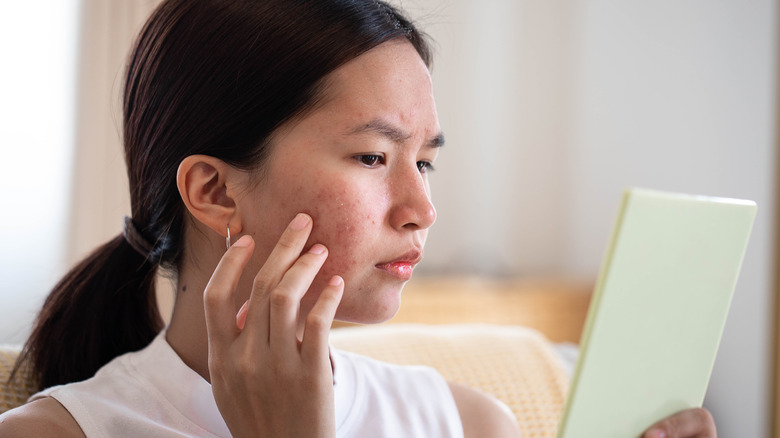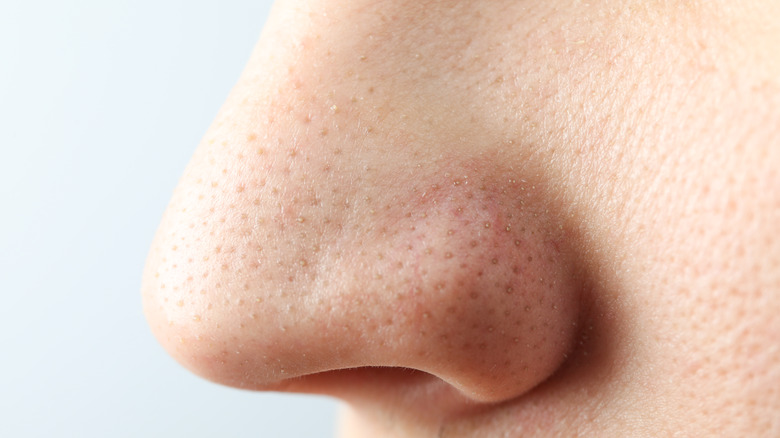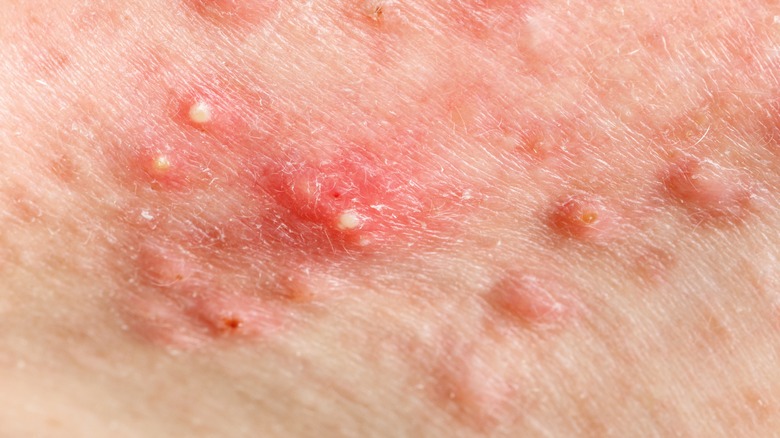Blackheads Vs. Whiteheads: Is There Really A Difference?
Unless you're one of the lucky few with perfect skin, chances are, you've experienced a blackhead or whitehead at some point in your life. According to the American Academy of Dermatology, as many as 50 million Americans deal with acne every year, while Cleveland Clinic claims between 10% and 20% of adolescents, regardless of skin type, have experienced blackheads and/or whiteheads.
Both blackheads and whiteheads are classified as comedones, which is the scientific term for a type of non-inflammatory acne caused by plugged-up pores or hair follicles. Both types can occur because of an increase of sebum production, irregular keratin formation, or a buildup of too much bacteria on the skin. They're also found all over the chest, back, and face, and relatively easy to treat.
However, as you can probably guess from the names, they're not the same thing. Starting with the obvious: Blackheads get their name from the fact that they're dark in color, while whiteheads are called such because they tend to be light in appearance. Nice and simple. But that's not where the differences end.
Blackheads and whiteheads form differently
Blackheads and whiteheads are both the result of clogged pores. However, the main difference between the two is where they're formed. Blackheads are categorized open comedones because they occur when a clogged up pore has an opening at the surface of the skin. Because of this opening, that sebum plug gets exposed to air and oxidizes, which is what's gives it that dark, speckled appearance. Typically, blackheads don't feel painful or uncomfortable, and are likely to vanish with proper care within eight weeks.
As you might have guessed, then, whiteheads are considered closed comedones, because the opening of the pore is "closed" or blocked off. As a result, all the bacteria and sebum doesn't get exposed to air, and stays light in color. Instead, the plug pushes up and forms a flesh-colored, raised bump or pimple underneath the skin's surface. Contrary to popular belief, they are not the same as pustules, which have visible pus.
They have some different treatments
As we know, both blackheads and whiteheads form similarly, which means the same treatments can be used to manage them. Cleveland Clinic recommends using products containing salicylic acid to exfoliate the skin, azelaic acid and benzoyl peroxide to target bad bacteria, and retinoids, which can help with clogged pores. Other methods of ridding your skin of blackheads and whiteheads include oral antibiotics or microdermabrasion, chemical peels, and laser skin resurfacing to remove the top layer of skin. For whiteheads, Medical News Today also recommends Alpha hydroxy acids (AHAs), or, if you prefer a natural remedy, raw honey, witch hazel, aloe vera, or lemon juice. Tea tree oil can be used on to treat both. Always test the area first to make sure what you're applying won't be too harsh.
There are also a few professional-approved at-home treatments you could try for whiteheads, but not so many safe treatments for blackheads. For whiteheads, Heyday skin therapist Joanne DeLeon told Business Insider you may want to try dissolving one tablespoon of baking soda into eight ounces of distilled water and then, once a week, applying a small amount to your whitehead(s) to dry them out. "This alkaline solution seeps into the follicles softening the clogged matter," she explained. When it comes to removal of blackheads or whiteheads though, it's always safest to leave it to a professional.
No matter if you're dealing with blackheads or whiteheads, though, it's important to refrain from squeezing them. Board certified dermatologist Dr. Jessie Cheung told Allure that picking at blackheads can press them further into your skin, resulting in even bigger pores. As for whiteheads, skin therapist Joanne DeLeon told Business Insider, "This will only introduce harmful bacteria, potentially leave a scar and can force the debris further down into the skin to cause those dreaded 'underground' blemishes


